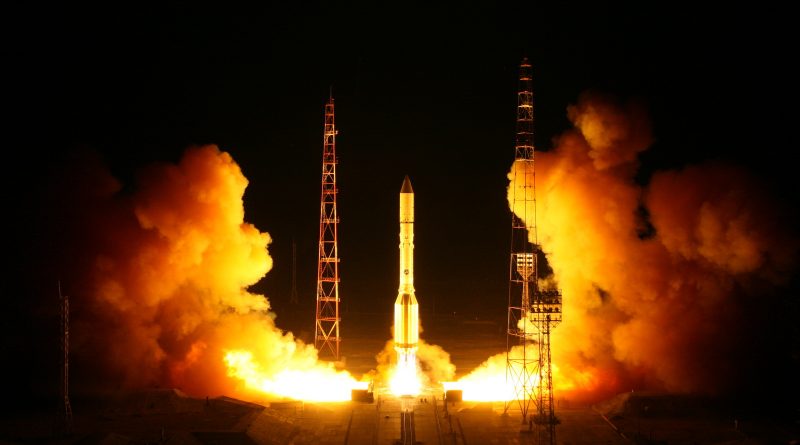Russia’s 2nd Blagovest Military Communications Satellite Blasts off on First Proton of 2018
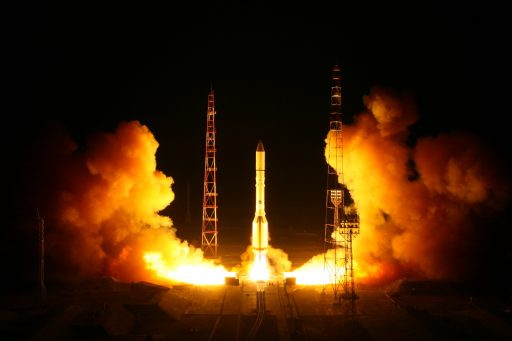
The thunder of Russia’s Proton rocket returned to the Baikonur Cosmodrome Wednesday night for the first time in seven months when the former workhorse of the Russian space program soared into the pre-dawn skies over the Kazakh launch site on a military mission. The task at hand for the heavy-lift vehicle was delivering the second satellite in the Defence Ministry’s Blagovest high-throughput communications system, but the mission was also hoped to continue re-building Proton’s reputation on the international market.
Liftoff at 22:12 UTC, 4:12 a.m. local time on Thursday, kicked off a lengthy mission to directly inject the Blagovest 12L satellite into a Geostationary Orbit. Given the military nature of the flight, no real time insight was available into the planned ten-minute climb by the three-stage Proton before the Briz-M upper stage was to take over for a four-burn mission taking a total of nine hours and three minutes from liftoff to separation of the satellite.
Roscosmos provided official confirmation of launch success at 8:05 UTC on Thursday after the satellite had been injected into its planned orbit.
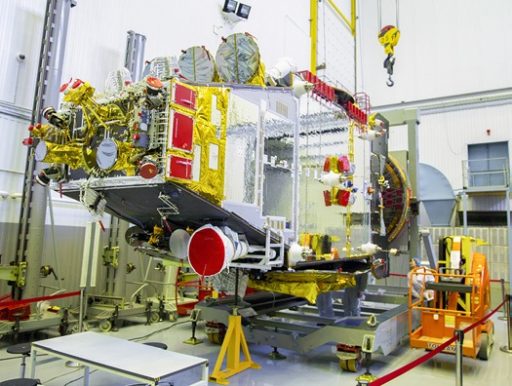
Re-named Kosmos 2526 after arriving in orbit, Blagovest 12L joins one constellation satellite launched in 2017 as the second member of a four-satellite system commissioned for data-intensive communications by the Russian government and armed forces as well as civilian exploitation for high-speed Internet connectivity and TV distribution. The secrecy surrounding their missions indicates Blagovest’s military role outweighs its part in commercial operations.
Thursday morning’s launch was not acknowledged in advance by any party involved in the mission and no photos or accounts of the launch are expected to be provided until the successful injection of the satellite is confirmed. Mirroring the August 2017 launch campaign of Blagovest 11L, information on the upcoming launch only came through air route closures that identified the primary launch window for Wednesday (UTC).
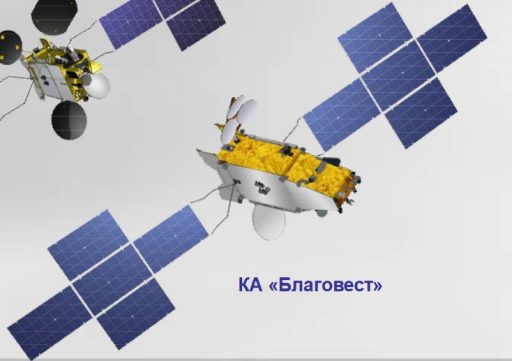
Blagovest, Russian for “Good News,” is also known under its code name of 14F149 and has been entirely funded by the Russian military. The constellation is expected to consist of at least four satellites parked at 45 and 128 degrees East in Geostationary Orbit to provide coverage across the Russian territory and the Eastern Hemisphere. Kosmos 2520, the first Blagovest launched last year, has taken up station at 45°E, indicating that the 12L satellite is headed to 128°E to advance the system to an initial operational capability across its planned coverage area.
The Blagovest satellites are built by ISS Reshetnev based on the company’s Ekspress-2000 satellite platform and fitted with high-throughput communications payloads operating in the Ka- and Q-Band frequencies. According to official information from Reshetnev, the satellites are primarily for connecting Russian military bases and government leadership but they also carry provisions for telephony, video conferencing, TV/radio broadcasting and Internet services – to be made available to large commercial customers.

Blagovest started out around 2010/11 and continued through its initial development stages in secrecy before being partially declassified in 2015 with an initial launch target in 2016. The launch of Kosmos 2520 ended up slipping significantly due to Proton’s engine troubles causing a year-long stand-down of launch operations for the refurbishment of potentially defective engine batches.
According to satellite builder Reshetnev, the Blagovest satellites host high-throughput payloads operating in the Ka-Band frequency (26.5-40 GHz) and the Q-Band Extremely High Frequency Range of 33 to 50 GHz, making the satellites some of the first to operationally use Q-Band communications that can support higher bandwidths. Documentation by Thales Alenia confirms Blagovest uses Q-Band filter equipment and Ka-Band input multiplexers from the company and a presentation by Spanish Company RYMSA also shows the satellite as having a C-Band payload – to be used to cater to heritage systems that do not yet support Ka-Band capability.
Q-Band is widely regarded as the future for high-throughput communications as it would allow for additional user bandwidth to be freed up by using Q-Band for the feeder links between the ground station and the satellite. However, implementation of Q-Band in an operational capacity is complicated by the fact that communications at these higher frequencies are susceptible to weather since rain can attenuate the millimeter-wavelength signals. This will require reliable mitigation either through switching between multiple ground hubs or employing adaptive coding and modulation techniques.
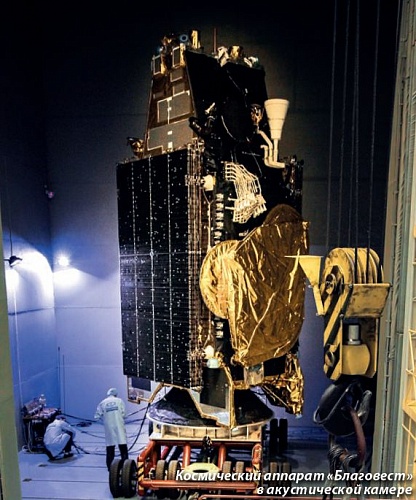
Some of the early adopters of Q/V-Band are the AlphaSat that carries an experimental package for studying how weather affects communications while commercial operator Eutelsat operates a Q/V-Band payload on their 65 West A satellite which has shown great promise via a series of test communications carried out in the 40-50 GHz band. A number of other telecommunications providers are actively pursuing EHF communications beyond Ka-Band including SpaceX that plans to launch nearly 12,000 satellites as part of their Starlink Constellation, mostly relying on V-Band (40-75 GHz).
Built for a 15-year service life, the Blagovest satellites use Reshetnev’s Ekspress-2000 platform that has previously flown on the Ekspress AM-5 and AM-6 missions as well as the Yamal-401 satellite – typically weighing between 3 and 3.5 metric tons at launch and offering a payload power of up to 15 Kilowatts, suitable for powerful communications packages and electric propulsion.
Each carrying in excess of thirty Ka-Band transponders plus C-Band capacity, the four-satellite Blagovest constellation will provide the Russian military with an immense increase in communications capability in terms of data throughput and coverage area. Before Blagovest, Russia relied on three Raduga-1M satellites in Geostationary Orbit and Meridian satellites in elliptical orbits for coverage of the northern latitudes.
Thursday’s early morning liftoff marked the first Proton launch since the successful delivery of AsiaSat-9 on September 28, 2017. In 2018, the heavy-lifter looks at another slow year dedicated to re-building and restoring confidence among its potential customer base after encountering failures or close calls nearly on an annual basis since 2006.
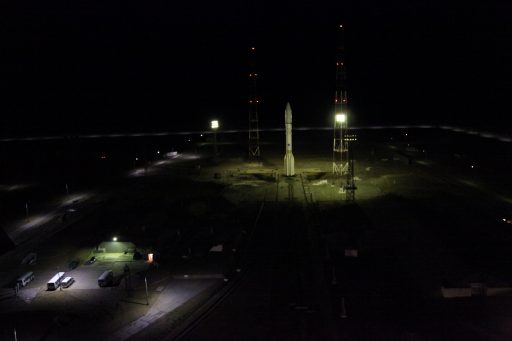
A string of failure-free missions is hoped to attract commercial business for the seasoned launch vehicle as well as the new Proton-Medium version envisioned to be more cost-effective for launches in the 5-metric-ton range.
Proton’s already short manifest for 2018 is dominated by uncertainty. Heading into the year, Proton was looking at up to six missions of which only the Blagovest launch was tracking toward a firm launch date. It was also clear that some of the payloads lined up on Proton’s near-term manifest stood almost no chance of flying in 2018: the MLM Nauka module has since been crossed off the 2018 list and is back at a NET 2019 target and the Spektr-RG radio telescope is also looking at liftoff in the spring of next year as late 2018 seems to be off the table even with a three-shift, seven-day work weeks at its manufacturer.
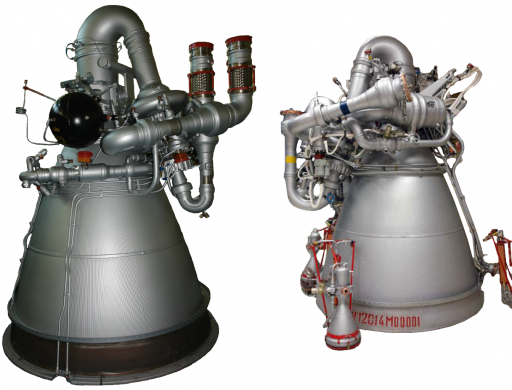
The lone commercial delivery originally on Proton’s 2018 manifest, involving the Orbital ATK-built Eutelsat 5 West B and Mission Extension Vehicle, is still listed for the fourth quarter, though appears likely to move into the first quarter of next year. This leaves Proton with three more or less firm launches in 2018: Thursday’s delivery of Blagovest, the launch of the Ekektro-L No. 3 weather satellite in October, and another defence ministry mission toward the end of the year.
However short Proton’s manifest for 2018 shapes up, the focus will be on getting all missions off without further trouble, aided by the conclusion of the inspection of nearly 60 engines that had been returned to their manufacturer VMZ in 2017. New equipment and procedures were also put in place at VMZ to strengthen quality control and eliminate risk to products arising from human error.
Sporting inspected and refurbished engines, the all-hypergolic Proton-M blasted off from Baikonur’s Site 81/24 at 22:12:00 UTC on Wednesday, lighting up the pre-dawn skies as it thundered off with a thrust of over 1,000 metric-ton-force. Powered uphill by six 1,657-Kilonewton RD-275M engines, the 58-meter tall Proton swung to the north east and passed Maximum Dynamic Pressure some 62 seconds after liftoff, setting out on a standard ascent mission of 9 minutes and 42 seconds to send the Briz-M upper stage on its way.
>>Proton-M Launch Vehicle Overview
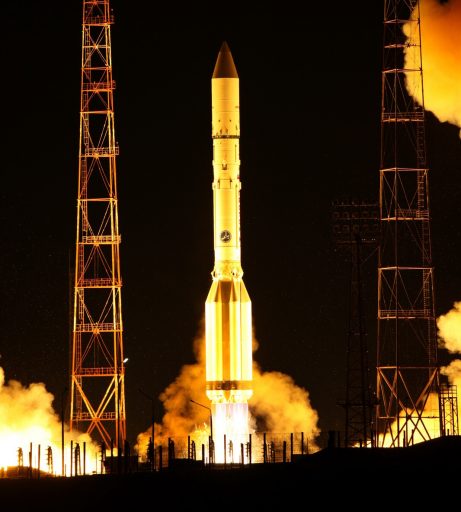
Burning some 3,600 Kilograms of hypergolic propellant per second, the 21-meter long first stage was to drop away one minute and 59 seconds into the flight as the second stage took over in a hot-staging sequence. Firing up its four 599-Kilonewton engines, the 14.5-meter second stage was planned to be in action for three minutes and 28 seconds.
The separation sequence between the second and third stage was also expected in hot-staging mode using the third stage’s four-chamber vernier engine to pull away from the spent second stage at T+5 minutes and 27 seconds, followed four seconds later by the ignition of the 583-Kilonewton main engine on its four-minute burn. Proton was to shed its payload fairing around 20 seconds into operation of the third stage, revealing the secretive payload for the rest of the ride into orbit.
Consuming 622 metric tons of self-igniting propellants over the course of nearly ten minutes, Proton’s job was sending the Briz-M upper stage on a sub-orbital trajectory from where it was to complete a gradual climb directly into a Geostationary Drift Orbit – creating a total mission duration of just over nine hours.
Based on last year’s Blagovest 11L mission, Briz-M was to start out with a four-minute burn of its 19.85-Kilonewton S5.98 engine to push the stack into a Low Earth Parking Orbit for a coast phase of a little under an hour.
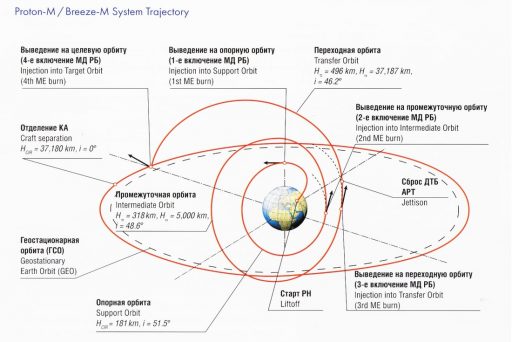
This allowed the second main engine burn, starting 67 minutes after launch and lasting 17.5 minutes, to occur on the ascending node and position the high point of the resulting orbit around 5,000 Kilometers above the equator on the opposite side of the planet.
Next was to be a coast phase of two hours to allow Briz-M to complete almost an entire lap around the planet so that the third burn, an 18-minute firing, could occur around the perigee and lift the apogee altitude to match Geostationary Orbit. After dropping its Auxiliary Propellant Tank, Briz entered the mission’s longest coast to climb all the way to the high point of the orbit before re-lighting its engine on a 13-minute burn designed to circularize the orbit and reduce its inclination to zero.
Separation of the Blagovest 12L satellite was expected around 7:15 UTC on Thursday and Roscosmos declared the 417th launch of Proton a success a short time later.

